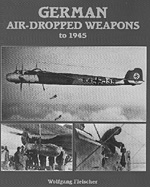
German Air-Dropped Weapons to 1945
by Wolfgang Fleischer,
Midland/Ian Allan, 2003, $44. 95, ISBN 1 85780 174 1
Lavishly illustrated with contemporary photos and drawings, this book is the most detailed treatment of German air ordnance ever written. It covers the development of air ordnance in WW I and between the wars, as well as during WW II. It discusses German experiments with chemical weapons between the wars, the technological challenges facing the designers as they tried to build weapons that would be effective against different types of targets. Most interesting is the discussion of the production difficulties encountered during WW II, when inferior materials caused the creation of Quality Classes (GŁteklasse) , for major ordnance, with I being the best and III the worst. Class I bombs could be used against any target, but were reserved for the most difficult, because Classes II and III were limited in the types of targets that could be engaged.
Detailed drawings describe the methods of construction, fuzing, and mounting on carrier aircraft. Explosive fills are also described in detail. The book covers experimental programs like the Rollbombe, as well as more famous weapons like the Hs 293 and Fritz-X. I have US Army ordnance manuals that provide the specifications of German air ordnance, but this goes farther, with history, and explanations.
I wish there were similar books for the air weapons of other countries. If you want detailed data on German ordnance, this is it.
BT
Back to The Naval Sitrep # 27 Table of Contents
Back to Naval Sitrep List of Issues
Back to MagWeb Master Magazine List
& copy Copyright 2004 by Larry Bond and Clash of Arms.
This article appears in MagWeb.com (Magazine Web) on the Internet World Wide Web.
Other military history and related articles are available at http://www.magweb.com